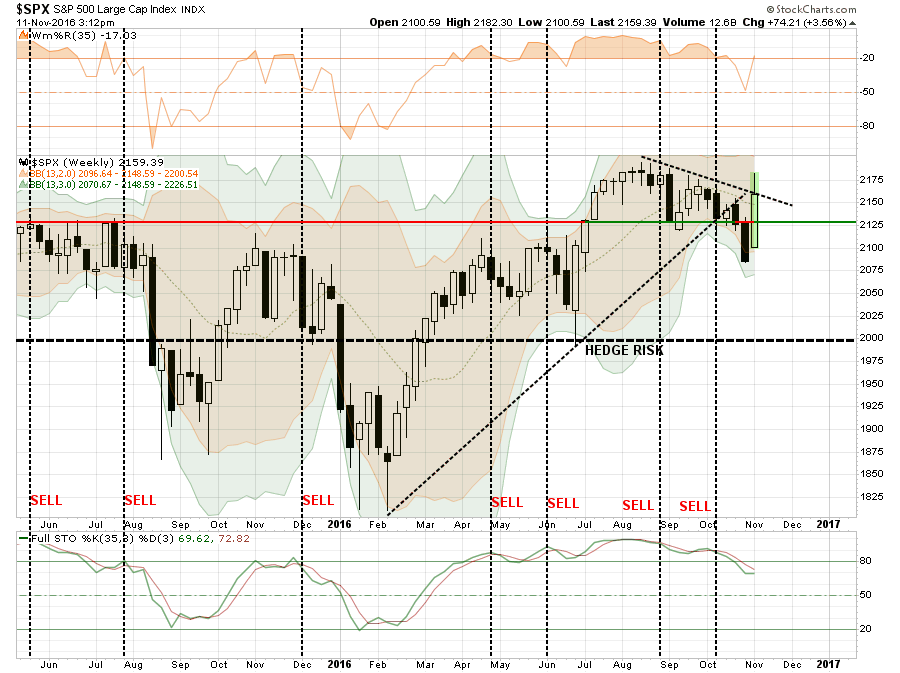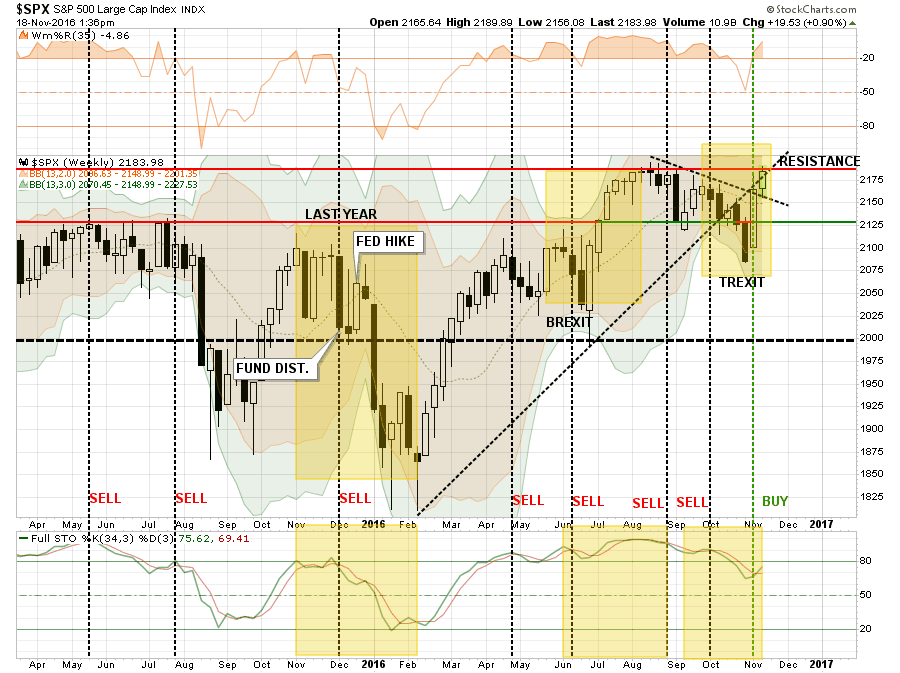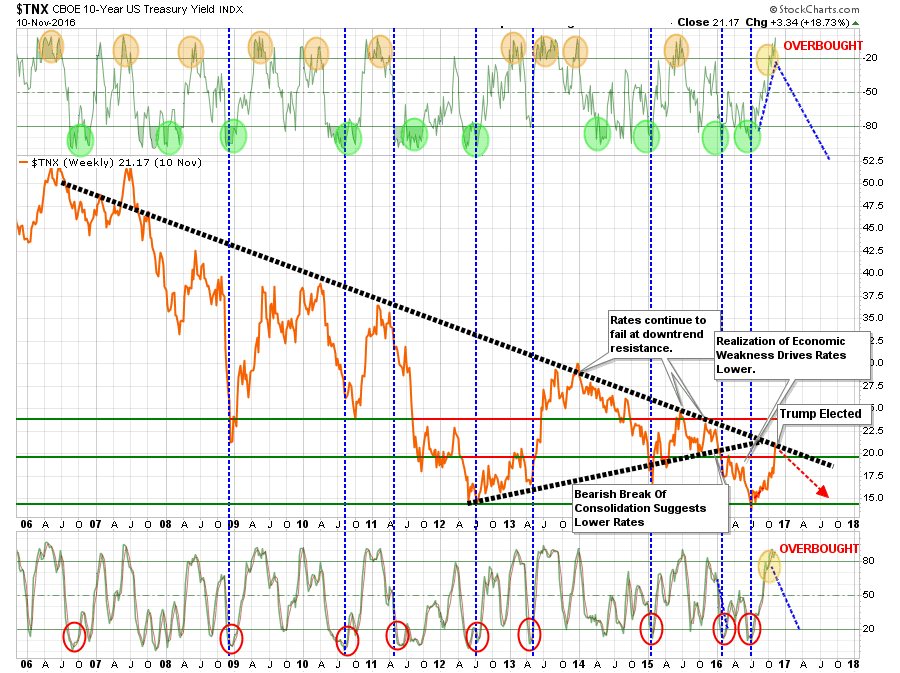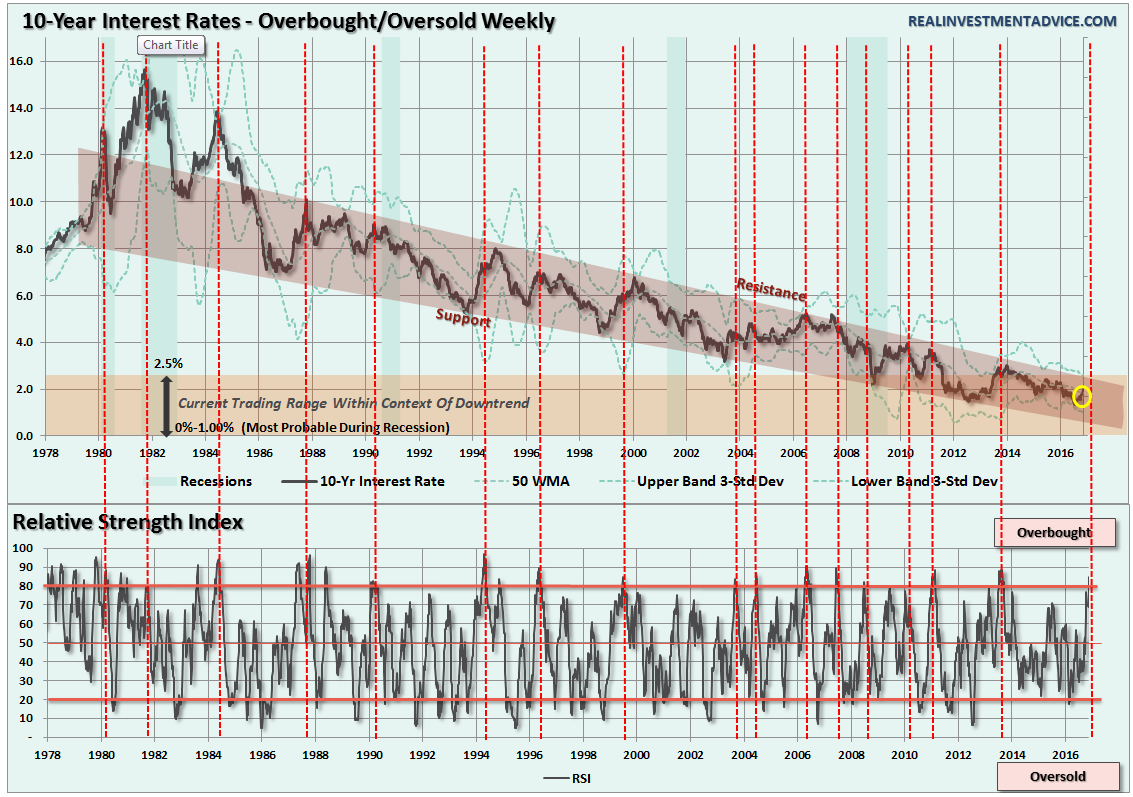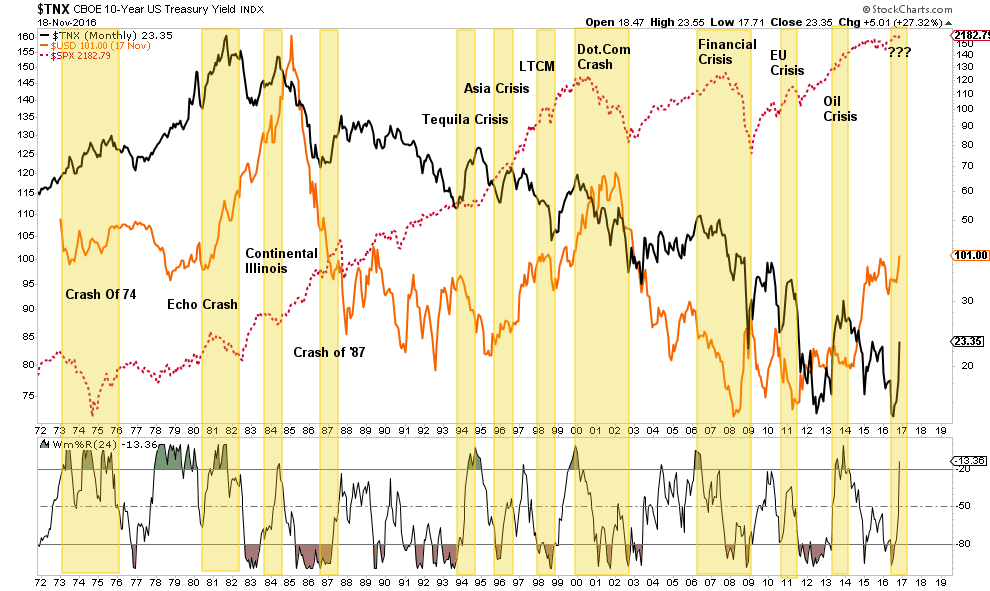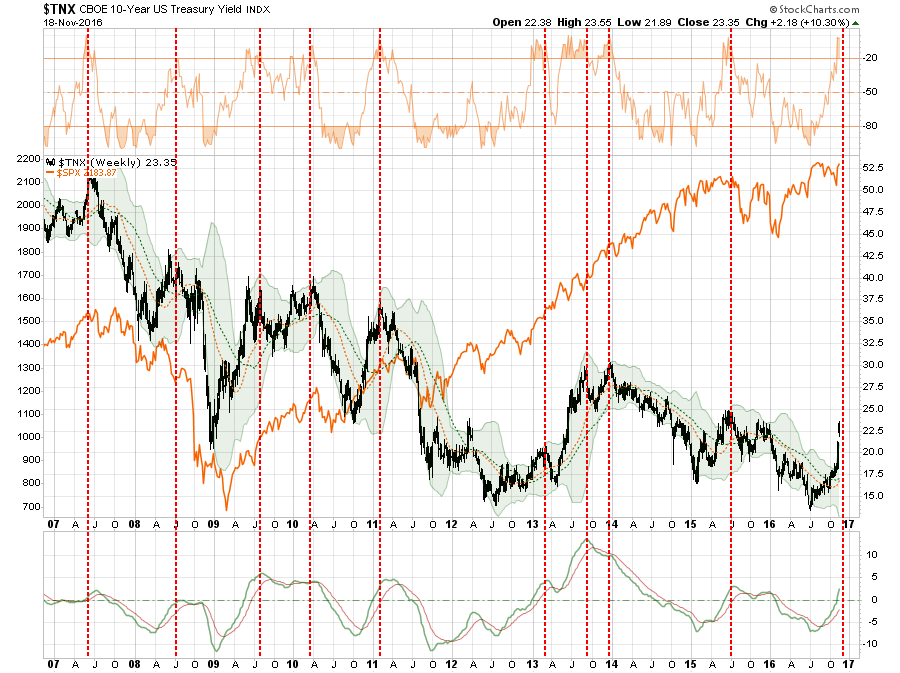Courtesy of Lance Roberts at RealInvestmentAdvice.com
Review
Let’s start with where we left off last week for some context.
“The post ‘Trexit’ rally that started on Wednesday took out the first two levels of resistance with some ease. However, the “sell signal” remains intact with the market now back to extreme overbought levels as shown by the red circles at the top of the chart.
The good news is the market is holding above the downtrend resistance line currently which puts all-time highs as the next logical point of attack if this bull market is to continue.
However, is we step back to a longer-term (weekly) picture we get a little clear picture about the overall directional trend of the market.”
The good news, as shown in the next chart, is the market was able to clear that downtrend resistance this week and turn the previous “sell signal” back up. It is not surprising the markets are pushing all-time highs as we saw on Friday.
But what about after that? As I noted on Friday:
“Importantly, with next week being a light trading week, it would not be surprising to see markets drift higher. However, expect a decline during the first couple of weeks of December as mutual funds and hedge funds deal with distributions and redemptions. That draw down, as seen in early last December, ran right into the Fed rate hike that set up the sharp January decline.”
As I have noted above, there are a lot of similarities in market action between the “post-Trexit” bounce, “Brexit” and last December’s Fed rate hike. I have highlighted there specific areas of note in the chart above.
As with “Brexit” this past June, the markets sold off heading into the vote assuming a vote to leave the Eurozone would be a catastrophe. However, as the vote became clear that Britain was voting to leave, global Central Banks leaped into action to push liquidity into the markets to remove the risk of a market meltdown. The same setup was seen as markets plunged on election night and once again liquidity was pushed into the markets to support asset prices forcing a short-squeeze higher.
But let’s go back to Thanksgiving of last year as well. As I wrote back then:
“With the markets currently oversold on a very short-term basis, the current probability is a rally into the ‘Thanksgiving’ holiday next week and potentially into the first week of December. As opposed to my rudimentary projections, the push higher will likely be a ‘choppy’ advance rather than a straight line.
In early December, I would expect the markets to once again pull back from an overbought condition as mutual funds distribute capital gains, dividends, and interest for the year. Such a pullback would once again reset the market for the traditional ‘Santa Claus’ rally as fund managers ‘window dress’ portfolios for their end-of-year reporting.
This is only an expectation based on seasonal tendencies of the market. As I have stated repeatedly, the current setup is opportunistic for very short-term, nimble and disciplined traders. However, for long-term investors looking to managing risk and preserve capital, the current market environment is no longer friendly and is beginning to border on hostile.”
Interestingly, that same analysis applies today just as much as it did a year ago. With the markets trying to play catch up after a sloppy summer, pushing extreme overbought conditions, and with the Fed once again lifting rates – the backdrop is all too familiar.
Combine the current backdrop with a sharply higher dollar and interest rates and you have all the makings for a rather nasty correction.
Everything Is Awesome
As Eric Parnell, CFA noted on Seeking Alpha this past weekend:
“The dawn of a new era of pro-growth economic policies has suddenly come upon us, filled with massive fiscal stimulus, generous tax cuts and decreased regulation. As a result, the time has come effectively overnight in investor portfolios to abandon the safe haven of U.S. Treasuries and get reflationary!”
The whole article is a very good read and digs into the misconceptions currently existing across asset markets. However, here is an important conclusion:
“Everything is NOT awesome. I’m not saying in this statement that things might not eventually become truly awesome someday in the future, as I genuinely hope they do and believe they can. But things have not suddenly become awesome over the course of the past week. Instead, it’s going to take a long (loooong) time and a lot of potentially painful and tenuous adjustments along the way to get back to awesome. And this does not mean that markets should not move well in advance to price in this potential awesome returning at some point in the future.
But outside of the rise of the U.S. stock market, which when you dissect it has taken place in three specific trading days with the vast majority of it coming the day after the election on Wednesday of last week, we are actually seeing very little evidence in securities prices of the supposed awesomeness that so many analysts and pundits are proclaiming is all but certain in recent days.
All of this raises an important point. It is very easy to be sucked into the gushingly positive narratives and often unsupported narratives put forth by the financial media. This is particularly true when the move in asset prices can make minutes seem like days and hours seem like months. But when it comes to managing your own investment portfolios, it is critically important to do your own research to confirm or refute the narratives that you are hearing. For the reasons for what is actually taking place at any given point in time may end up leading to decidedly different outcomes.
This also leads to perhaps an even more important point. We should all remember that just as a stock market can rise relentlessly and valuations can increase despite a largely stagnant economy thanks to extraordinarily accommodative monetary policy, so too can a stock market fall relentlessly and valuations compress despite a steadily growing economy as a result of restrictive monetary policy.
In fact, monetary policy does not even need to be restrictive to see stocks fall into a bear market. For so much air has been put under a stock market that continues to trade at its highest valuations in history that even a solidly growing economy can come with a good dose of valuation compression.”
Excessive market valuations, weak internal measures, and a deteriorating backdrop has historically been a “wicked brew” for investor outcomes.
While markets can certainly remain “irrational longer than you can remain solvent,” the secret to “solvency” is understanding “when” to make an investment “bet.” A professional gambler only goes “all-in” when he “knows” he has a winning hand. He also knows when to “fold” and minimize his losses. For long-term investors, the risk to “solvency” greatly exceeds the “reward” currently.
For short-term traders, a breakout to new highs will likely provide a short-term trading opportunity to speculate in the market. However, gains will likely be limited and risk of failure is high.
The Great Bond Crash of 2016
“OMG…Are interest rates ever going to stop rising? My bond funds are getting crushed.”
Actually, it isn’t just bond funds it is all interest rate sensitive sectors of the market. But, as I have discussed many times in the past, this is the problem particularly with bond funds and ETF’s – WHICH ARE NOT BONDS.
Actual bonds, which are the only thing you should buy for fixed income in your portfolio, have two key factors:
- An actual interest payment is made at specific intervals during the life of the bond, and;
- A return of principal function at maturity.
Everything else, bond funds, bond ETF’s, preferred stocks, REIT’s, MLP’s, closed-end funds, and target-date funds that have been passed off as bond substitutes, ARE NOT BONDS.
Interest rates sensitive investments are a trade on the direction of interest rates, just as stocks are a trade on the direction of the equity markets. No more. No less.
And, as you have seen recently, they can, do and will lose value.
However, let’s also put the recent correction in rates into a bit of perspective.
Let’s start with my analysis from last week:
“However, the spike in rates this past week, now has me buying bond ETF”s for a trading opportunity. As shown below, interest rates are now pushing overbought conditions only seen near absolute peaks in interest rates movements. (Orange circles)”
“What is interesting is that stock buyers are told to buy stocks after big corrections, yet it works EXACTLY the same way with bonds. When interest rates spike, bonds become VERY oversold and operate on exactly the same premises as stocks.
So, bonds are now EXTREMELY oversold and this is as good of an opportunity as one will get to buy bonds.
Does this mean rates will plunge on Monday? No. Rates could go a bit higher from here, but it will likely not be much. As Jeff Gundlach stated last week:
“I do think this rate rise is about 80% through. If yields rise beyond ‘critical resistance’ levels, including 2.35% on the 10-year note, then things are in really big trouble.”
He is right, higher rates negatively impact economic growth. But in BOTH CASES, the outcome for bonds is EXCELLENT.”
Rates did drift slightly higher this week as stated but still well within the context of the long-term downtrend. The chart below shows the long-term trend of the 10-year Treasury going back to 1978 as compared to its RSI index and I have circled the recent “surge” in rates.
When put into this context, the rise is barely noticeable. However, what is notable is that historically whenever the RSI on rates has exceeded 80%, red dashed lines, it has preceded a subsequent decline in rates. In other words, overbought rates are a signal to buy oversold bonds for a potential reversion trade.
However, the coincident surge in both rates AND the dollar have also put the markets at risk of a bigger “impact correction” due to the simultaneous strain the surging dollar and rates put on foreign exchange and economies. History is littered with incidents that have coincided with similar environments.
Sure, this time could be different…it just usually isn’t.
As Horseman Capital recently penned in a letter to their investors:
“The problem with sharply higher US bond yield is that this tightens financial conditions. We have often seen rises in yield coincide with financial market crises. A rise in yields preceded the 1987 market crash. A rise in yield in 1994 preceded the Tequila crisis, when the Mexican peso devalued by half. After both events, yields quickly fell to new lows. Yields rose in 1996/7 before the Asian Financial Crisis, and yields again rose in 1999 before the dot com crash. After both events, yields fell to new lows. More recently, bond yields rose in 2006 before the Global Financial Crisis, and again in 2010/1 before the Euro-crisis. There was also a rise in yields before the crash in oil prices in 2014. In all cases yields fells to new low.”
Let me repeat:
“While the punditry continues to push a narrative that ‘stocks are the only game in town,’ this will likely turn out to be poor advice. But such is the nature of a media driven analysis with a lack of historical experience or perspective.
From many perspectives, the real risk of the heavy equity exposure in portfolios is outweighed by the potential for further reward. The realization of ‘risk,’ when it occurs, will lead to a rapid unwinding of the markets pushing volatility higher and bond yields lower.”
Here is the most important point.
“Just one month ago, we were told that U.S. equities should rise because bond yields would be low forever, discount rates should trend toward 0% and therefore equity valuations should trend toward infinity over time. Now, we’re told that despite bond yields surging we can still count on U.S. equities trending toward infinity because they’re better positioned to absorb higher rates than emerging markets.”
It can’t be both.
While the belief currently is the policies being promoted by President-elect Trump are both stimulative and inflationary, my view aligns with Dr. Lacy Hunt of Hoisington Capital Management:
“Markets have a pronounced tendency to rush to judgment when policy changes occur. When the Obama stimulus of 2009 was announced the presumption was that it would lead to an inflationary boom. Similarly, the unveiling of QE1 raised expectations of a runaway inflation.
Yet, neither happened. The economics are not different. Under present conditions, it is our judgment that the declining secular trend in Treasury bond yields remains intact.”
This is the most important point. Over the intermediate to longer-term time frame, when considering economic and fundamental underpinnings, the consequences of aggressive equity exposure are entirely negative as the rising dollar/yield combination exacerbates the ongoing earnings recession.
In other words, a traditionally overvalued equity market will die a very traditional death.



